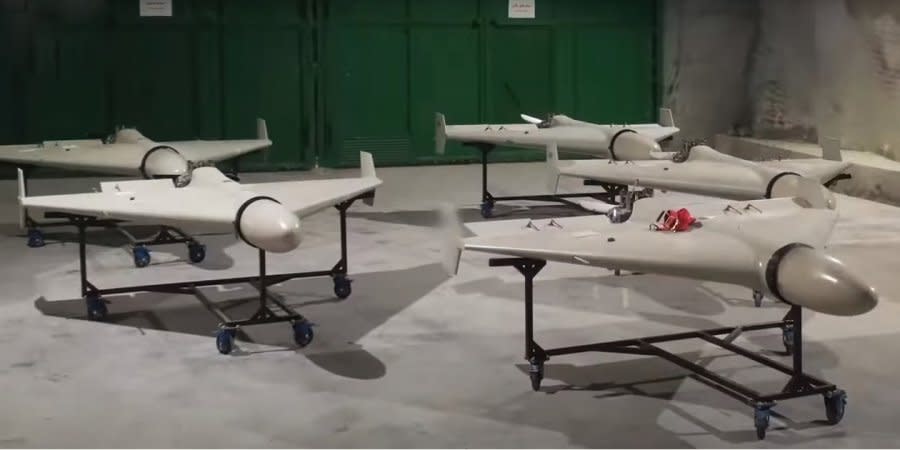Military expert on Iranian Shahed-136 drones in service with Russia

The first such drone was shot down by the Armed Forces of Ukraine on Sept. 12 near the town of Kupyansk in Kharkiv Oblast, and over the past week the aggressor has been using these aircraft more and more often. They have been spotted in the skies over Dnipropetrovsk, Odesa and Mykolaiv oblasts.
The southern city of Odesa was attacked by three Iranian drones at once on Sept. 23. Even though one of them was shot down by Ukrainian air defenses, the other two hit a city administration building, resulting in one civilian being killed and another one being injured.
Read also: Sharp-shooting Ukrainian air defenses bag two enemy warplanes and a drone in quick succession
During this time, Ukrainian air defenses destroyed around 18 Iranian drones, and it is known the Russian army has rebranded them as Geran-2 drones.
NV asked Oleg Katkov, the editor-in-chief of the Ukrainian portal Defense Express, to explain the dangers these drones pose to the Ukrainian army.
NV: Tell us, what kind of drone is this?
Katkov: This is not quite a drone in the traditional sense of the word. Of course, this is an unmanned aerial vehicle (UAV), but it is a loitering ammunition, or, as they are also called, a kamikaze drone. This UAV does not carry out any reconnaissance, does not return to the starting point, it is disposable and is designed to hit ground targets.
Judging by the appearance of Shahed-136, which can be seen in the available video and photo materials, in particular from Iran, no video camera or any other sensor is seen on this drone. Given this, it can be assumed that satellite navigation is its only source of guidance.
That is, it is guided exclusively to stationary objects by the coordinates it receives from satellite navigation systems, such as GPS or GLONASS. And given that Iran is under sanctions and apparently does not have access to Western components with conventional military GPS, it uses an ordinary civilian GPS sensor that can be purchased on AliExpress. After all, there is a high probability that the Iranian drone was assembled from electronic components available on the market.
Even the engine for the Shahed-136 is available on AliExpress. I’m saying all this for you to understand that this is not some kind of superweapon.
Regarding the characteristics of this drone (this is all according to Iranian sources): wingspan – 2.5 m, length – 3.5 m, maximum take-off weight – 200 kg. The warhead usually accounts for about 25-30% of the take-off weight (up to 50-60 kg).
As for the flight range, we have to be extremely cautious about this. The flight range of this UAV declared by Iran is a fantastic 1,500-2,500 kilometers. But this is more than doubtful. Because in that case, it would have to be much larger, much heavier, and its engine would not be a 50 horse power moped engine. In other words, it would have been a more serious device. Therefore, in the case of Shahed-136, we are talking about a maximum of several hundred kilometers of flight.
NV: In your opinion, how dangerous is this weapon for us?
Katkov: Due to the fact that this UAV most likely uses satellite navigation for guidance, it is completely dependent on civilian GPS. Therefore, with the means available to the Armed Forces of Ukraine, it is technically possible to effectively jam, in particular, GPS signals. Especially since jamming such a civilian class signal is not some kind of know-how. Such “jammers” are sold on AliExpress.
The second aspect is the overall reliability of the Iranian drone. Since this equipment is assembled from low-quality parts, the reliability will be low. That is why the tactics of using these UAVs involves their use in a so-called swarm, i.e. when relatively low accuracy and relatively low reliability are compensated by mass launch. In other words, five to six, or even more, kamikaze drones are launched at one target, assuming that a few of them will fulfil their task.

NV: And how can we fight these drones in this case?
Katkov: When such UAVs are used en masse, it is quite difficult to fight them off. Because this is actually a small-sized, low-altitude target, and it is quite a difficult task for any air defense system to deal with such a group of targets.
It should be taken into account that kamikaze drones appeared on the battlefield relatively recently, somewhere in the 2010s. They were something exotic at that time, and the world had a skeptical attitude toward them. And only after it was demonstrated in Nagorno-Karabakh region that kamikaze drones can be effective on the battlefield, did these UAVs begin to be popular.
But the world has not yet mass-produced extremely effective means of countering this threat. Of course, there are developments. The first of them are related to anti-aircraft artillery, which has projectiles with remote detonation. And since mass production has not yet been established, such a projectile is quite expensive.
And secondly, serial production of laser complexes with a combat laser with a power of more than 50 kW is being developed now. And this is the most economically justified decision.
Read also: Iran’s provision of drones to Moscow supports the murder of Ukrainains, says President’s Office
To understand: it is unlikely that a drone assembled from components from AliExpress will cost hundreds of thousands of dollars. Therefore, it is trivially unprofitable to shoot it down with a missile, which can cost from $300,000. And the resource of automatic guns of anti-aircraft systems, such as the German Gepard or the Soviet Tunguska, is quite small, while the maintenance costs for such class systems are high. Thus, it is unprofitable to shoot these drones even from ordinary artillery anti-aircraft systems.
That is why laser complexes look like a quite effective means of combating these UAVs. But the production of such complexes is still just being developed. First of all, Israel has such a system, the Iron Beam air defense system. The United States has experimental pre-series samples, and Turkey has the Alka laser complex. But here we are also talking about pieces.
Therefore, GPS signal jamming, masking and changing positions, collapsing (embankments), setting false positions (layouts) are the logical means of countering Shahed-136 for now.
NV: How can the use of these drones by the Russian army affect the course of the war?
Katkov: If we do not neglect these UAVs, use means of radio-electronic warfare and take camouflage measures, this threat will be reduced, but it will still remain. However, to say that these drones will lead to some breakthrough on the battlefield or change the general situation on the fronts is 100% not. In the end, everything depends on the number of these weapons and the time for their manufacture.
NV: And how many such drones could Russia purchase in general?
Read also: US confirms Iranian drone transfer to Russia
Katkov: It is unknown. I would focus on a few hundred, up to a maximum of 1,000 pieces. The fact is that we do not even know how many such drones Iran itself has.
But if we think logically, the first batch of weapons (presumably hundreds in number) is purchased at first, it is checked for the effectiveness, after which a decision is made whether to continue the purchase or not.
After all, if Iran began to produce such UAVs, there is a risk that Russia will constantly purchase them or, perhaps, will produce a localized copy of this drone on its own.
Read the original article on The New Voice of Ukraine

